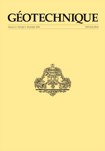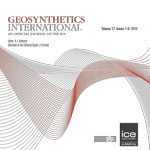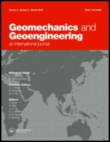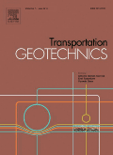
Journal of the Korean Geosynthetic Society
Scope & Guideline
Shaping Tomorrow’s Infrastructure with Innovative Geosynthetics
Introduction
Aims and Scopes
- Geotechnical Engineering Innovations:
The journal emphasizes research on innovative techniques and materials in geotechnical engineering, including the study of soil behavior, stability analysis, and structural integrity under various loading conditions. - Geosynthetic Applications:
Focusing on the development and application of geosynthetic materials, the journal publishes works that explore their effectiveness in soil stabilization, erosion control, and environmental protection. - Numerical Modeling and Analysis:
A significant portion of the research involves the use of numerical modeling techniques to analyze complex geotechnical problems, providing insights into soil-structure interactions and performance predictions. - Field Studies and Practical Applications:
The journal values empirical research through field studies that validate theoretical models and provide practical solutions to real-world engineering challenges. - Environmental and Sustainability Issues:
Research addressing environmental impacts, sustainability, and the use of recycled materials in geotechnical applications is also a core focus, reflecting the growing importance of these themes in engineering.
Trending and Emerging
- Integration of IoT and AI in Geotechnics:
Recent publications highlight the increasing use of Internet of Things (IoT) devices and artificial intelligence (AI) in monitoring and analyzing geotechnical structures, enhancing predictive maintenance and real-time data utilization. - Sustainable and Environmentally Friendly Solutions:
There is a growing emphasis on sustainability, with research focusing on the use of eco-friendly materials and methods in geotechnical engineering, including the application of recycled materials for ground improvement. - Advanced Numerical and Computational Techniques:
The rise of advanced computational methods, including machine learning and hybrid modeling techniques, is evident, showcasing their potential in solving complex geotechnical problems. - Climate Change Impacts on Geotechnical Engineering:
Emerging studies are increasingly addressing the implications of climate change on soil behavior and the stability of geotechnical structures, reflecting a heightened awareness of environmental challenges. - Seismic and Dynamic Behavior Analysis:
Research on the seismic performance of geotechnical structures is trending, with a focus on dynamic analyses that consider the effects of earthquakes and other dynamic loads on soil and structures.
Declining or Waning
- Traditional Soil Testing Methods:
Although foundational to geotechnical engineering, traditional soil testing methods are being overshadowed by more advanced techniques, such as in-situ testing and remote sensing technologies. - Conventional Materials in Soil Stabilization:
Research on conventional materials for soil stabilization is decreasing as the field shifts towards the use of innovative, sustainable materials, such as geopolymers and recycled products. - Static Analysis of Structures:
The focus on static analysis methods for assessing soil-structure interactions is waning as dynamic analysis and real-time monitoring techniques gain prominence due to their relevance in understanding performance under variable conditions. - Limited Scope of Historical Case Studies:
While case studies have been essential, there is a noticeable decline in the publication of studies focusing solely on historical data without incorporating modern analytical techniques or innovative materials.
Similar Journals

Soils and Rocks
Uncovering Insights Beneath Our FeetSoils and Rocks is an academic journal dedicated to the field of Geotechnical Engineering and Engineering Geology, published by the Brazilian Association of Soil Mechanics and Geotechnical Engineering in collaboration with the Portuguese Geotechnical Society. Since becoming an Open Access platform in 2011, this journal has provided a vital publication outlet for researchers and professionals seeking to disseminate their findings on soil behavior, rock mechanics, and related topics within an international context. The journal is indexed in Scopus, holding a rank of 177 out of 229 in its category as of 2023, placing it in the 22nd percentile among its peers. Operating out of Brazil, Soils and Rocks encourages rigorous scholarly exchange and exploration of innovative practices within the sectors, making it an important resource for advancing knowledge in the geotechnical community. With a converged publication history from 2007 to 2024, the journal aims to foster significant advancements and insights that enhance our understanding of subsurface conditions and materials.

PROCEEDINGS OF THE INSTITUTION OF CIVIL ENGINEERS-GEOTECHNICAL ENGINEERING
Exploring Innovative Solutions in Earth SciencesPROCEEDINGS OF THE INSTITUTION OF CIVIL ENGINEERS-GEOTECHNICAL ENGINEERING, published by Emerald Group Publishing Ltd, is a prestigious journal that serves the dynamic field of geotechnical engineering and broader earth sciences. With an ISSN of 1353-2618 and an E-ISSN of 1751-8563, this journal has established itself as a vital resource for researchers, professionals, and students alike, offering insights into innovative practices and developments within the geotechnical domain. It ranks within the Q2 category for Earth and Planetary Sciences and Geotechnical Engineering as of 2023, demonstrating its significant impact and relevance in these fields. Given its comprehensive scope from 1994 to 2024, the journal provides a platform for high-quality research articles, case studies, and technical notes, although it presently does not offer open access options. Researchers seeking to publish their work will find this journal an essential venue for reaching an audience deeply invested in the advancement of geotechnical methodologies and solutions.

GEOTECHNIQUE
Exploring Earth Sciences to Build Tomorrow's FoundationsGEOTECHNIQUE is a prestigious peer-reviewed journal published by Emerald Group Publishing Ltd, specializing in the fields of Geotechnical Engineering and Earth and Planetary Sciences. Established in 1948, this journal has consistently delivered groundbreaking research and advancements in the science of soil and rock mechanics, engineering geology, and environmental applications, aiming to foster innovation in geotechnical practices. With an impressive impact factor reflected in its Q1 ranking within both the Earth and Planetary Sciences and Geotechnical Engineering categories, GEOTECHNIQUE is recognized as a leading source of scholarly articles, positioning itself among the top 5% in the field. The journal is accessible via subscription, providing a repository of invaluable insights for researchers, professionals, and students striving to push the boundaries of knowledge and application in geotechnical topics. With a robust editorial board and a commitment to excellence, GEOTECHNIQUE continues to contribute significantly to the academic community and the practical engineering landscape.

GEOSYNTHETICS INTERNATIONAL
Redefining Civil Engineering Through GeosyntheticsGEOSYNTHETICS INTERNATIONAL, published by EMERALD GROUP PUBLISHING LTD, is a leading journal in the fields of Civil and Structural Engineering and Geotechnical Engineering, recognized for its significant contributions since its inception in 1994. With an impressive impact factor reflecting its esteemed reputation—ranking in the top quartile (Q1) for both primary categories—this journal serves as a critical platform for the dissemination of cutting-edge research and innovations related to synthetic materials in geotechnical applications. Researchers, professionals, and students alike benefit from access to peer-reviewed articles that explore both theoretical advancements and practical implementations of geosynthetics, addressing complex engineering challenges and environmental considerations. Given its commendable rankings in Scopus, where it stands at Rank #73 in Civil and Structural Engineering and Rank #46 in Geotechnical Engineering, with an 80th percentile performance, the journal not only enhances scholarly dialogue but also influences industry practices. GEOSYNTHETICS INTERNATIONAL continues to play a pivotal role in shaping future directions in engineering and sustainability.

Geomechanics and Geoengineering-An International Journal
Pioneering Research in Geomechanics and GeoengineeringGeomechanics and Geoengineering-An International Journal, published by Taylor & Francis Ltd, serves as a prominent platform for the dissemination of innovative research and advancements in the fields of Geotechnical Engineering and Engineering Geology. With an ISSN of 1748-6025 and E-ISSN of 1748-6033, this journal has established itself as a critical resource within its category, ranking in the Q2 quartile according to the 2023 metrics and positioning itself in the top 38% of the Scopus rankings for Earth and Planetary Sciences. Geomechanics and Geoengineering encompasses a diverse range of topics, including but not limited to soil mechanics, foundation engineering, rock mechanics, and environmental geotechnics, ultimately aiming to advance both theoretical and practical knowledge in these vital areas. This journal not only highlights pioneering research but also facilitates a platform for academia and industry practitioners to collaborate and exchange ideas. While it does not offer open access, it remains a valuable resource for institutions and individuals committed to enhancing their expertise in the geotechnical domain. With convergence years spanning from 2006 to 2024, this journal is equipped to significantly contribute to the evolving landscape of geomechanical research.

Acta Geotechnica Slovenica
Exploring the Depths of Earth Science Innovation.Acta Geotechnica Slovenica is a distinguished peer-reviewed journal published by the University of Maribor, Slovenia, that focuses on the fields of geology, geophysics, and geotechnical engineering. With an ISSN of 1854-0171, it showcases significant research contributions that enhance our understanding of geotechnical challenges and innovations. The journal has been active since 2008 and has gained recognition within the academic community, holding a Q3 quartile ranking in Geology and a Q4 ranking in Geophysics and Geotechnical Engineering and Engineering Geology as per the 2023 categorization. Even though there are no Open Access options available, the journal remains an important resource for researchers, professionals, and students alike, serving as a platform for disseminating impactful findings in earth science disciplines. Its relevance is underscored by its rankings in Scopus, positioning it among the notable journals in its field. Engaging with Acta Geotechnica Slovenica offers an invaluable opportunity to stay at the forefront of geotechnical research and advancements.

Geotechnical and Geological Engineering
Innovating Solutions for a Sustainable Geological FutureGeotechnical and Geological Engineering, published by SPRINGER, is a premier journal dedicated to advancing the field of geotechnical and geological engineering. With a strong reputation demonstrated by a robust impact factor and notable Scopus rankings, the journal positions itself in the top quartile of categories such as Architecture and Geotechnical Engineering, making it an essential resource for researchers and practitioners alike. Established in 1991 and continuing through 2024, it provides a platform for original research that addresses the pivotal challenges in soil science, geology, and engineering geology. Although it does not offer open access, it remains accessible through institutional and personal subscriptions, ensuring that academic scholars, industry professionals, and students can engage with high-quality, peer-reviewed content. The journal's commitment to disseminating innovative findings and fostering interdisciplinary dialogue underscores its vital role in shaping future developments in engineering and environmental sustainability.

Transportation Geotechnics
Pioneering Insights for Sustainable Transport Systems.Transportation Geotechnics is a premier academic journal published by Elsevier, focusing on the intersection of geotechnical engineering and transportation systems. With an impressive impact factor and categorized in the Q1 quartile across multiple disciplines including Civil and Structural Engineering, Geotechnical Engineering, and Transportation, this journal stands as a vital resource for researchers and practitioners alike. It covers a broad spectrum of topics ranging from soil behavior in transport contexts to innovative materials and methods that enhance infrastructure stability and performance. As an essential platform fostering knowledge dissemination, Transportation Geotechnics enables contributors to share their groundbreaking findings while providing readers with access to cutting-edge research and reviews from 2014 to 2024. Its illustrious Scopus rankings place it prominently in the global research landscape, making it an indispensable tool for students, professionals, and academics dedicated to advancing the field.

Proceedings of the Institution of Civil Engineers-Ground Improvement
Driving Research for Sustainable Building PracticesProceedings of the Institution of Civil Engineers-Ground Improvement is a distinguished journal published by EMERALD GROUP PUBLISHING LTD, dedicated to advancing knowledge and research in the fields of Building and Construction, Geotechnical Engineering, Mechanics of Materials, and Soil Science. With an ISSN of 1755-0750 and an E-ISSN of 1755-0769, this journal has been a vital platform for disseminating innovative research since its inception in 2008. With an impact factor placing it in the Q3 category across multiple engineering disciplines, it ranks favorably in Scopus, ensuring visibility and recognition among scholars globally. The journal offers open access options, allowing for broader dissemination of research findings. Targeting researchers, professionals, and students alike, it aims to foster discussions on ground improvement technologies and methodologies that are essential for sustainable infrastructure development. As it continues to converge its focus until 2024, the Proceedings stands as an imperative resource for those seeking to elevate their understanding and contribute to the ever-evolving field of civil engineering.

International Journal of GEOMATE
Shaping the future of engineering with cutting-edge insights.The International Journal of GEOMATE, published by GEOMATE INT SOC based in Japan, is a pivotal resource for scholars and practitioners in the fields of Building and Construction, Environmental Engineering, Geotechnical Engineering, and Soil Science. Established in 2011 and continuing to set the standard in its focus areas, this journal serves as a platform for innovative research and practical applications, with contributions that significantly enhance the understanding and development of sustainable engineering practices. With its current classification in the Q3 quartile across multiple categories, it strives to disseminate critical knowledge and foster dialogue among a diverse audience, including researchers, industry professionals, and students. Though operating under a traditional subscription model, the journal's emphasis on rigorous peer review and high-quality publications ensures a substantial impact factor, further reinforcing its reputation in academia. Spanning from 2011 to 2024, the International Journal of GEOMATE invites contributions that advance the knowledge frontier and address contemporary challenges in engineering and environmental science.